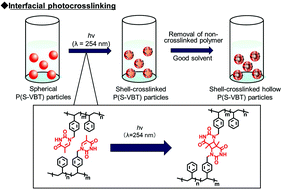Interfacial photocrosslinking of polymer particles possessing nucleobase photoreactive groups for hollow/capsule polymer fabrication†
Abstract
Hollow and capsule polymer particles have great potential for use in various applications such as coatings, microreactors, and drug delivery systems. The strategy of the interfacial photocrosslinking of spherical polymer particles is promising for creating a wide range of functional hollow and capsule particles. Herein, polystyrene-based particles possessing nucleobases in polymer side chains were prepared and nucleobase groups were applied to the interfacial photocrosslinking as photoreactive groups for the first time. In this interfacial photocrosslinking, [2π + 2π] photoinduced dimerization between nucleobases proceeds only at the particle/water interface under photoirradiation, and subsequent removal of non-crosslinked polymers results in the formation of shell-crosslinked hollow particles. 4-Vinylbenzyl thymine (VBT) was prepared as a styrene-based photoreactive monomer, and the [2π + 2π] photoreactive dimerization property of poly(VBT-co-styrene) was confirmed, leading to the fabrication of shell-crosslinked hollow polymer particles. Owing to the strong hydrogen bonding property of thymine groups, the washing process for removing non-crosslinked polymers from photoirradiated particles was optimized. Furthermore, the encapsulation of a model dye was successfully performed.



 Please wait while we load your content...
Please wait while we load your content...